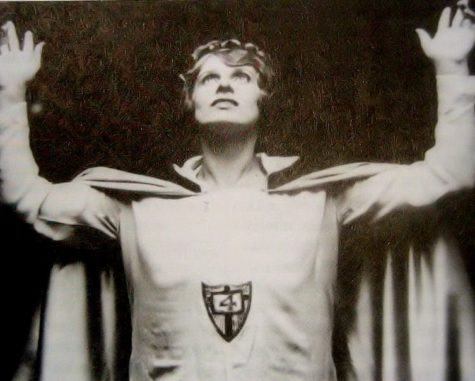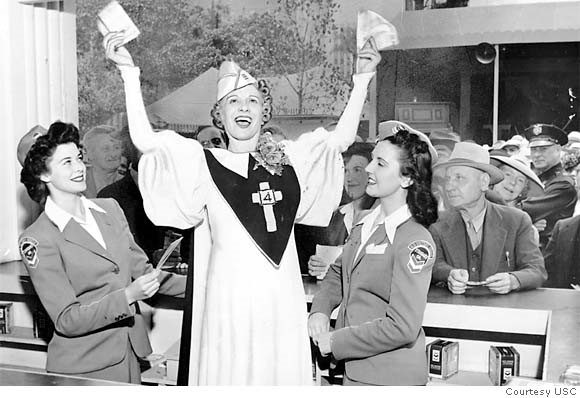The Gospel According to Sister Aimee for organ, brass and percussion (2012)
I. Knock Out the Devil!
II. An Evangelist Drowns/Desert Dance
III. To the Promised Land
Instrumentation: Organ, 4 Horns, 4 C Trumpets (straight metal mute), 3 Trombones (3. Bass), Tuba, Timpani (Four drums; 32” 29” 26” 23″), Percussion (2 Players; instruments are not shared): 1. Tambourine, Vibraslap, Whip, Tenor Drum, Piccolo Snare Drum, 2. Glockenspiel, Wood Blocks, Vibraslap, Crash Cymbals, Suspended Cymbal (yarn mallets), 2 Triangles (large and medium)
Publisher: Michael Daugherty Music
Duration: 16 minutes
World Premiere: February 23, 2012 / Costa Mesa, California / Segerstrom Concert Hall, Pacific Symphony Orchestra / Carl St. Clair, conductor / Paul Jacobs, organ soloist
Program Note:
The Gospel According to Sister Aimee (2012) for organ, brass and percussion was commissioned by Pacific Symphony, Music Director Carl St.Clair and the San Diego State University School of Music and Dance (SDSU) for its 75th anniversary celebration and the SDSU Wind Symphony, Shannon Kitelinger, conductor. The first performance took place on February 23, 2012 by Pacific Symphony, conducted by Carl St.Clair with Paul Jacobs, organ soloist.
The Gospel According to Sister Aimee is my musical portrait of the rise, fall and redemption of Aimee Semple McPherson (1890-1944), the first important religious celebrity of the new mass media era of the 1930s. Also known as Sister Aimee, she was able to combine Pentecostal “old-time” religion, patriotism and theatrical pizzazz like no other religious leader of her time. For over 35 years, Sister Aimee, bible in hand, delivered legendary sermons, often speaking in tongues, and practiced faith healing from coast to coast at revivals held in tents, town squares, opera houses and boxing rings across America.
In order to bring her evangelical message to an even greater audience, Sister Aimee preached her conservative gospel in progressive ways by utilizing radio, movies and journalism. Her fundamentalist “Foursquare Gospel” warned standing-room-only crowds at revivals and radio audiences that drinking, gambling, dancing, Hollywood and the teaching of evolution all represented “agencies of the devil to distract the attention of men and women away from spirituality.”
At the same time, Sister Aimee was a woman ahead of her time who campaigned for the right of women to vote, and for gender and racial equality. In later life, she was the target of numerous critics, including other evangelists, who viewed her lavish life style, opulent fashion wardrobe, over the top theatrics and questionable love life as hypocritical and “modernist.”
After a decade of living a nomadic life and preaching from town to town in revivals across America, she eventually settled in Los Angeles. Raising over a million dollars in donations, she built the spectacular Angelus Temple near Echo Park, a five thousand-seat mega church that opened in 1923. Sister Aimee’s extravagant Sunday services, which were broadcast on her radio station and attended by thousands of followers from all walks of life, were accompanied by the Silver Brass Band and a mighty Kimball pipe organ. Inspired by her larger-than-life melodramatic persona, my composition for organ, brass and percussion is divided into three movements.
I. Knock Out the Devil!
In the first movement of my concerto, I summon the organ, brass and percussion to call to mind a revival meeting held by Sister Aimee after a boxing match in a San Diego amphitheatre. To publicize the revival, Sister Aimee, wearing her trademark white robe, walked throughout the crowd with a huge sign inviting the audience to join her after the fight to “Knock out the Devil!” My music incorporates punchy polyrhythms and multi-layered polychords to create the rhythmic energy of a musical revival.
II. An Evangelist Drowns/Desert Dance
On May 16, 1926, at the peak of her fame, Sister Aimee went for a swim near Venice Beach in Los Angeles and mysteriously vanished. Thousands gathered on the beach to pay their respects. But had she really drowned? A month later, she was discovered in a Mexican village. She claimed she was kidnapped for ransom and had escaped by walking hours through the desert to freedom. However the Los Angeles District Attorney accused Sister Aimee of faking her disappearance, in order to run off with a married man who was the radio engineer at the Angelus Temple.
As one of Sister Aimee’s most vocal critics, Upton Sinclair fictionalized her life in Elmer Gantry (1926) and published an ironic poem about her supposed death in “An Evangelist Drowns.” In this poem the evangelist exclaims, “What’s this? A terror-spasm grips / My heart-strings, and my reason slips. / Oh, God, it cannot be that I, / The bearer of Thy Word, should die!” The poem concludes: “Ten thousand to my aid would run, / Bring me my magic microphone!” In the second movement, I reflect on the contradictory stories about Sister Aimee’s death and resurrection by composing two kinds of music that interrupt each other. In the organ cadenza we hear cluster chords in descending cadences, alternating with a diabolic scherzo performed on the organ’s foot pedals. This dramatic alternation suggests Sister Aimee’s fall from grace plunging into the sea, and the dance with her demons as she wanders through the desert.
III. To the Promised Land
After the scandal, Sister Aimee slowly rebuilt her reputation by focusing on charitable endeavors. She opened a 24-hour soup kitchen and free health clinic for the needy at her Angelus Temple, and participated in War Bond rallies during the Second World War. The night before she was to preach her popular “Story of My Life” at a revival, Sister Aimee accidentally took a fatal dose of sleeping pills and never woke up. In the third movement of my organ concerto, I create a hymn for Sister Aimee in her final hours, remembering her humble beginnings as a child in the Salvation Army, her rise to fame, her fall from grace, and her return as America’s most admired evangelist. The music crescendos to a dramatic conclusion, as she dreams of her final comeback, returning to the “pearly gates” of heaven and the biblical “promised land.”
–Michael Daugherty


